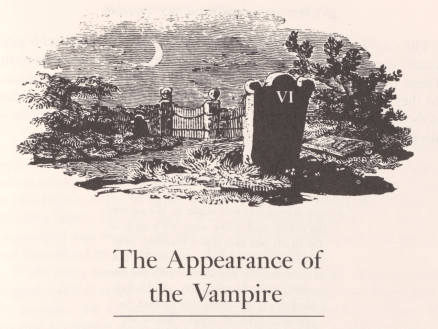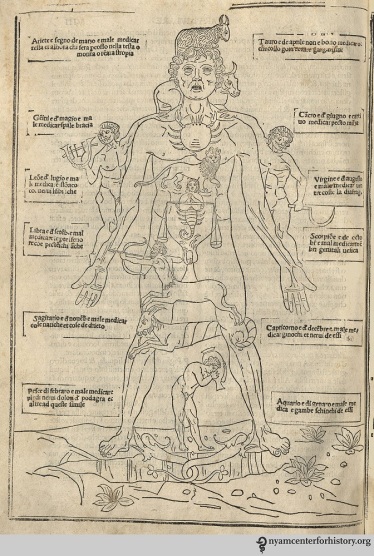By Audrey Sage Lorberfeld, Digital Technical Specialist
Most people associate vampires with Bram Stoker’s Count Dracula; however, the vampire has much older roots than that. Robert McCully reports that “the earliest known depiction of a vampire appears on a prehistoric Assyrian bowl…”[1] Much later came the vampiric texts with which we in the West are familiar, like Samuel Taylor Coleridge’s Christobel (1797), Marquis de Sade’s Justine (1791), and John Keats’s Lamia (1819).[2] Finally, in 1897, comes Stoker’s Dracula.

Chapter heading illustration, from Paul Barber’s Vampires Burial and Death: Folklore and Reality, 1988.
Perhaps the easiest place to start a history of the vampire is the differentiation between the folkloric vampire and the fictional vampire.
The Folkloric Vampire
Paul Barber warns that “if a typical vampire of folklore…were to come to your house this Halloween, you might open the door to encounter a plump Slavic fellow with long fingernails and a stubby beard, his mouth and left eye open, his face ruddy and swollen… [his] nose fallen in somewhat, the hair, beard, and nails grown, and new skin formed under the old” (a lovely phenomenon called ‘skin slippage’).[3] Other telltale signs of folkloric vamps are that people usually kill them with stakes (the act of which causes them to bleed and emanate ‘painful’ sounds); they like to attack cattle; they can regenerate;[4] and they bite.[5]
Regarding the origins of the folkloric vamp, Barber puts forth a forensic and socio-political argument. In short, Barber thinks that the idea of the folkloric vampire arose from the exhumation of decomposing bodies. These bodies normally have a little blood at their mouths, they get bloated, they smell, and they bleed when cut.[6] Barber believes that these bodies were likely scapegoats for society’s fears of plague or murder victims, whose bodies were buried in shallow graves (meaning that they decomposed faster).[7] When these ‘vampires’ were exhumed for inspection (which happened when a corpse was accused of being a vampire) and were ‘killed’ with stakes, it would be normal for a decomposing body to lack rigor mortis and also let out a painful sound, like the one mentioned previously. In reality, this sound is just the bloated body expelling methane.[8]
The Fictional Vampire
The fictional vamp, on the other hand, is the pop culture phenomenon. These vampires are “power mad” and want “nothing less than to take over the world, with the aid of an army of subordinate vampires.”[9]
This fictional vamp is the creature to which the real-life disease porphyria can be (dubiously) linked. Porphyria is a term given to multiple diseases that involve “enzyme defects in the haem biosynthetic pathway.”[10] Coming from the Greek word πορφύρα (pronounced “por-FOO-ra”), meaning purple, porphyria sufferers usually have red- or purple-tinged urine. This discoloration is caused by an excess of porphyrins.[11] Porphyrins are “light-activated chemicals that can be used to combat ills including tumors and diseases of the eye.”[12] Porphyria is also the disease many think plagued King George III.[13]
The specific type of porphyria most link to vampires is congenital erythropoietic porphyria (CEP), otherwise known as Gunther’s Disease.[14] Roderick McEwin writes that “this extremely rare disease presents on first exposure to light . . . blistering [the] exposed skin,” and that the urine, teeth, and bones, all stained pink, fluoresce in ultraviolet light.[15] These symptoms would explain why we usually associate vampires with burning in the sun.
Regarding the blood-sucking behavior of typical (fictional) vampires, Lane writes that it is possible early scientists linked vampires to porphyria patients because, in principle, it is possible to relieve the symptoms of porphyria by drinking blood. Not all scholars buy this argument, however. Maranda et al argue that there is no “scientific explanation for why people with porphyria would benefit from drinking blood” and that true porphyria patients suffer from scarring, which does not complement the world’s perception of (fictional) vampires.[16]
Another belief is that vampires arose from real people getting rabies. Juan Gómez-Alonso writes about how rabies sometimes presents in spasms and the emission of hoarse sounds that together make someone’s teeth clench and lips retract like those of an animal. The spasms are “generally triggered by some stimuli,” which include light (“photophobia”). Rabies might also explain vampires’ relationships to mirrors. Gómez-Alonso tells us that “a man was not considered rabid if he was able to stand the sight of his own image in a mirror.”[17]
There is almost too much that could be said about the vampire’s history. The vampire has been around for a long time, and continues to be a source of fascination. In fact, the next time you are on the 6 train, just look up and check out the ad for Casper® mattresses.

Casper® ad on the number 6 subway line in New York City, photograph by author, 2017.
Further Reading:
- Read the article that inspired this post: Dowling, Stephen. “The Real-life Diseases That Spread the Vampire Myth.” BBC. October 31, 2016.
- You can read a longer version of this blog post on the author’s website.
References:
[1] McCully, Robert. “Vampirism: Historical Perspective and Underlying Process in Relation to a Case of Auto-Vampirism.” Vampires, Werewolves, and Demons: Twentieth Century Reports in the Psychiatric Literature, edited by Richard Noll, New York: Brunner/Mazel; 1992: p. 38.
[2] Ibid.
[3] Barber, Paul. Vampires, Burial, and Death: Folklore and Reality. New Haven: Yale University Press; 1988: 2-13.
[4] Ibid., 19.
[5] Ibid., 32.
[6] Ibid., 121.
[7] Ibid., 124-5.
[8] Ibid., 158.
[9] McCully, 83.
[10] Youngs, Giles R., ed. Dobson’s Complaint: The Story of the Chester Porphyria. London: Royal College of Physicians of London; 1998: 1.
[11] McEwin, Roderick. Porphyria in Australia: A Review of the Literature, and the Australian Experience. Sydney: Health Commission of New South Wales; 1975: 6.
[12] Lane, Nick. “Born to the Purple: The Story of Porphyria.” Scientific American. December 16, 2002.
[13] Youngs, 11.
[14] McEwin, 43.
[15] Ibid.
[16] Maranda, Eric Laurent et al. “Porphyria and Vampirism-A Myth, Sensationalized.” JAMA dermatology 152.9 (2016): 975.
[17] Gómez-Alonso, J. “Rabies: A Possible Explanation for the Vampire Legend.” Neurology 51.3 (1998): 856–859.






